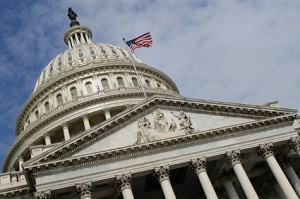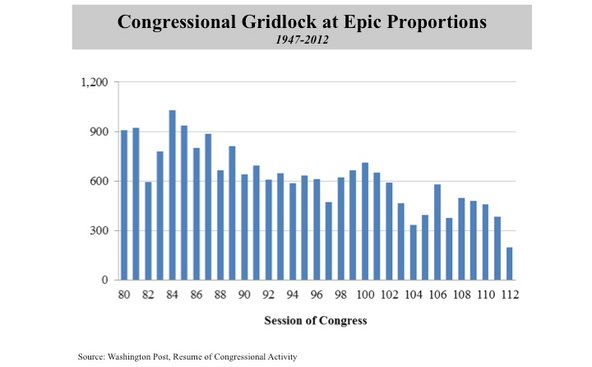Congress In Contempt, Part 1: The Fiscal Cliff Is Only One Example Of Congressional Failure
 There was a moment when the Founding Fathers considered putting a provision in the Constitution that would allow citizens to recall members of Congress. The proposal failed. As a result, only members of Congress can remove other members of Congress from office.
There was a moment when the Founding Fathers considered putting a provision in the Constitution that would allow citizens to recall members of Congress. The proposal failed. As a result, only members of Congress can remove other members of Congress from office.It’s a pity. As the 112th Congress passes into an ignominious history and a not-much-different 113th Congress takes over, one wishes the citizenry had the right to kick members out of office not just during an election year, but any time they don’t do their jobs. Clearly, members of Congress are not doing their jobs today. By one measure, 95% of Americans think lawmakers are doing a lousy job. One suspects the other 5% are the members of Congress themselves, along with their staffs and families.
The fiscal cliff debacle is merely the latest case in which our derelict and dysfunctional Congress has put the nation’s families, businesses and the overall economy at risk. Even though Congress reached a last-minute agreement on the fiscal cliff last night, significant damage already has been done by the politics of brinkmanship. From failing to fund Superstorm Sandy relief to outright denial of climate change, Congress has proved itself particularly inept.

Consider: While Congress went home for Christmas without reaching an agreement on taxes and spending, some 12 million Americans spent the holiday jobless. Two million of them lost their unemployment compensation when the crystal ball in Times Square hit bottom at the cusp of the New Year.
The health of America’s small businesses was a significant campaign issue in 2012, but it doesn’t seem to be a concern on Capitol Hill now that the election is over. The prospect of higher taxes and deep cuts in government programs caused consumer confidence to plummet six points in December, the most important time of year for business earnings, even more important this year as the economy continues climbing out of the pit created by the recession.
Think back over the last two years. The genesis of the fiscal cliff was Congress’s standoff on raising the national debt ceiling in 2011. Legislation finally was approved only hours before the federal government defaulted on its debts. Citing this “political brinksmanship” as a sign that Congress is “less able, less effective and less predictable” in managing the nation’s fiscal affairs, Standard & Poor’s took the unprecedented step of lowering America’s credit rating.
After last November’s election, in which voters seemed to signal they wanted an end to block-headed partisanship, congressional leaders expressed optimism they’d reach a deal on taxes and spending before the end of the year. The fiscal cliff debacle indicates, however, that Congress didn’t get the message from voters or from Standard & Poor’s. And another big cliff is just ahead: The need to raise the debt ceiling again in the next few weeks. The possible consequences of another standoff have been described by Jonathan Masters of the Council on Foreign Relations:
Many analysts say congressional gridlock over the debt limit will likely sow significant uncertainty in the bond markets and place upward pressure on interest rates. Rate increases would not only hike future borrowing costs of the federal government, but would also raise capital costs for struggling U.S. businesses and cash-strapped homebuyers. In addition, rising rates could divert future taxpayer money away from much-needed federal investments in such areas as infrastructure, education, and health care…Speaking to the Economic Club of New York in November 2012, Fed Chairman Ben Bernanke warned that congressional inaction with regard to the fiscal cliff, the raising of the debt ceiling, and the longer-term budget situation was creating uncertainty that “appears already to be affecting private spending and investment decisions and may be contributing to an increased sense of caution in financial markets, with adverse effects on the economy.”
Masters points out that for all the rhetoric about economic stability and fiscal discipline, the debt ceiling standoff in 2011 actually added to government waste and the economy’s jitters:
A 2012 study by the non-partisan Government Accountability Office estimated that delays in raising the debt ceiling in 2011 cost taxpayers approximately $1.3 billion for FY 2011. BPC (the Bipartisan Policy Center in Washington D.C.) estimated the ten-year costs of the prolonged fight at roughly $19 billion.
The stock market also was thrown into frenzy in the lead-up to and aftermath of the 2011 debt limit debate, with the Dow Jones Industrial Average plunging roughly 2,000 points from the final days of July through the first days of August. Indeed, the Dow recorded one of its worst single-day drops in history on August 8, the day after the S&P downgrade, tumbling 635 points.
Lawmakers in the modern era have been inept at timely decisions on spending in general. American families found something new in their stockings this Christmas: The threat that milk prices would double after Jan. 1 because Congress failed to reauthorize the nation’s farm program when it expired earlier in the year. Worse, farm experts warned the nation’s agricultural sector would be thrown into turmoil. As the year ended, lawmakers extended the program temporarily for one year, pushing the milk can down the road.
Last June, Congress finally approved a national transportation bill three years after the old bill expired, but only after 130 mayors from 36 states petitioned congressional leaders to finally get the job done.
Congressional cowardice is on full display when it’s time to approve the federal government’s annual budgets. Members avoided making tough budget decisions just before the November election by failing to approve a new budget when old one expired on Oct. 1. Congress finally approved a temporary budget bill just a week before the federal government would have been forced to shut down. The temporary budget – still in effect today — essentially puts federal agencies on hold until at least next March, after the 113th Congress has been seated and when the next election is still 20 months away.
Stop-gap budgets have become a tradition in Congress. As Brendan Greeley reports on Bloomberg Businessweek:
Since 1952, according to the Congressional Research Service, Congress has completed its spending bills by its own deadlines only four times—in 1977, 1989, 1995, and 1997. Year after year, lawmakers enact continuing resolutions to tide agencies over until appropriations bills pass. Fiscal year 2011—all 365 days of it—was paid for this way. Though a hyperpartisan year on Capitol Hill, it was by no means exceptional. According to the CRS, 178 days every year, on average, have been funded through continuing resolutions since 1977. Basically, half the time there is no budget.
What are the consequences? More wasted money and government inefficiency. Greeley continues:
The uncertainty creates all kinds of inefficiencies,..(F)ederal contractors build a risk premium into their fees, charging back to taxpayers the extra uncertainty of potential funding disruptions. Agency leaders also have trouble staffing for new projects when there’s no budget. They have to resort to signing contracts on a monthly rather than an annual basis. Because every contract costs money to close, more contracts mean greater administrative and legal costs…
And the inefficiencies don’t end when the appropriations finally come through. Contractors or hires with critical skills may already have found other work. Agencies have trouble spending what they then receive before the end of the fiscal year.
Congress doesn’t tell us how much its tardy budgeting costs taxpayers, but it sometimes can’t hide the costs of partisan grandstanding. For example, with important legislative work languishing, House Republicans held 33 votes to repeal Obamacare by July of last year, even though it was clear the Senate would never agree. As Huffington Post reported:
While Republicans lambast the cost of implementing health care reform, a new report shows that their efforts to repeal the law have come at a major cost to taxpayers — to the tune of nearly $50 million…Republicans’ many fruitless attempts at repealing the Affordable Care Act have taken up at least 80 hours of time on the House floor since 2010, amounting to two full work weeks. As the House, according to the Congressional Research Service, costs taxpayers $24 million a week to operate, those two weeks amounted to a total cost of approximately $48 million.
In large part because of delays in the Senate’s confirmation of President Obama’s appointments, Chief Justice John Roberts reported on Dec. 31 that “judicial emergencies” have developed in 27 jurisdictions where judicial vacancies have not been filled. “The pattern throughout (President Obama’s) tenure has been uncontroversial judicial nominees…going nowhere on the Senate floor,” according to Jennifer Bendery’s analysis of last year’s Senate confirmation process on Huffington Post.
While extreme weather caused unprecedented levels of damage to communities across the United States in 2012, the 112th Congress avoided discussing, let alone acting on, global climate change. It failed to pass the Violence Against Women Act. Red and blue states have lost thousands of jobs in the emerging wind energy industry because Congress stalled on passing the Production Tax Credit for utility-scale wind development by year’s end. And while bargaining to cut spending on programs such as Medicare and Social Security, lawmakers refused to touch sacred cows like the billions of dollars of unnecessary taxpayer subsidies Congress gives the oil industry.
Last November’s election was an opportunity for voters to discipline Congress for all of this. But even with public approval of Congress at one of the lowest levels ever, 91% of the members up for reelection in November were returned to office.
We appear to be a masochistic electorate and Congress appears to count on it and to holds us in contempt. That’s not likely to change until we impose the discipline on it that it’s unwilling to impose upon itself.
You can return to the main Market News page, or press the Back button on your browser.

